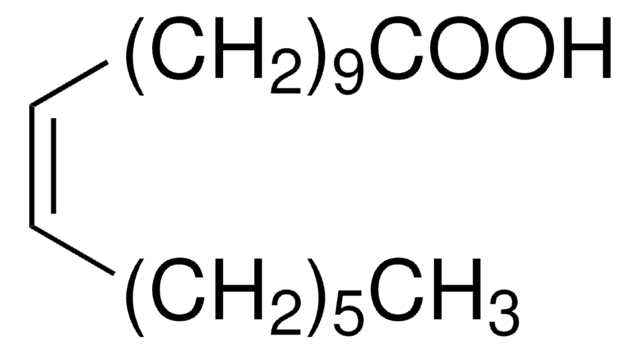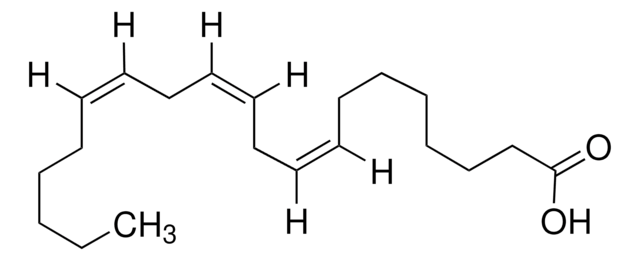Key Documents
P9417
Palmitoleic acid
≥98.5% (GC), liquid
Synonim(y):
cis-9-Palmitoleic acid, cis-9-Hexadecenoic acid
About This Item
Polecane produkty
pochodzenie biologiczne
Macadamia integrifolia
Próba
≥98.5% (GC)
Postać
liquid
współczynnik refrakcji
n20/D 1.457 (lit.)
tw
162 °C/0.6 mmHg (lit.)
mp
0.5 °C (lit.)
gęstość
0.895 g/mL at 20 °C (lit.)
grupa funkcyjna
carboxylic acid
oleic acid
typ lipidu
unsaturated FAs
Warunki transportu
ambient
temp. przechowywania
−20°C
ciąg SMILES
CCCCCC\C=C/CCCCCCCC(O)=O
InChI
1S/C16H30O2/c1-2-3-4-5-6-7-8-9-10-11-12-13-14-15-16(17)18/h7-8H,2-6,9-15H2,1H3,(H,17,18)/b8-7-
Klucz InChI
SECPZKHBENQXJG-FPLPWBNLSA-N
Szukasz podobnych produktów? Odwiedź Przewodnik dotyczący porównywania produktów
Zastosowanie
- to supplement Minimum Essential Media alpha (MEMα) to culture mouse spermatogonial stem cells (SSCs)
- as a component of a defined serum-free medium for the long-term propagation of SSCs
- in Dulbecco′s Modified Eagle Medium (DMEM) in the media for fatty acid treatment to assure a physiologic ratio between bound and unbound free fatty acid (FFA)
Działania biochem./fizjol.
Hasło ostrzegawcze
Warning
Zwroty wskazujące rodzaj zagrożenia
Zwroty wskazujące środki ostrożności
Klasyfikacja zagrożeń
Aquatic Chronic 4 - Eye Irrit. 2 - Skin Irrit. 2 - STOT SE 3
Organy docelowe
Respiratory system
Kod klasy składowania
10 - Combustible liquids
Klasa zagrożenia wodnego (WGK)
WGK 1
Temperatura zapłonu (°F)
143.6 °F - closed cup
Temperatura zapłonu (°C)
62 °C - closed cup
Środki ochrony indywidualnej
Eyeshields, Gloves, type ABEK (EN14387) respirator filter
Certyfikaty analizy (CoA)
Poszukaj Certyfikaty analizy (CoA), wpisując numer partii/serii produktów. Numery serii i partii można znaleźć na etykiecie produktu po słowach „seria” lub „partia”.
Masz już ten produkt?
Dokumenty związane z niedawno zakupionymi produktami zostały zamieszczone w Bibliotece dokumentów.
Klienci oglądali również te produkty
Produkty
Lipid Induced Insulin Resistance
Nasz zespół naukowców ma doświadczenie we wszystkich obszarach badań, w tym w naukach przyrodniczych, materiałoznawstwie, syntezie chemicznej, chromatografii, analityce i wielu innych dziedzinach.
Skontaktuj się z zespołem ds. pomocy technicznej












